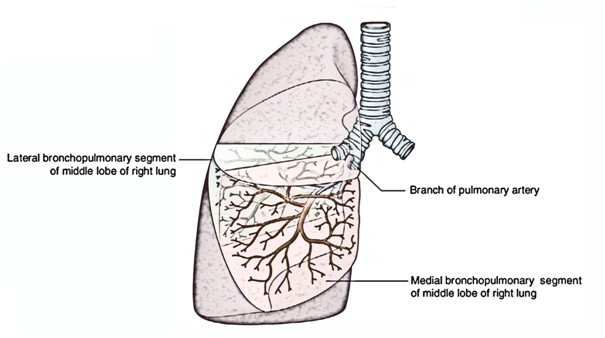The Bronchopulmonary sections are well defined, wedge ¬ shaped sectors of the lung, that are aerated by tertiary (segmental) bronchi.
- It’s a subsection of the lobe of the lung.
- It’s pyramidal in shape with apex pointed in the direction of the hilum and base in the direction of the top layer of the lung.
- It’s encompassed by the connective tissue.
- It’s aerated by the segmental (tertiary) bronchus.
- Every section has its very own artery, a segmental branch of the pulmonary artery.
- Every section has its own lymphatic drainage and autonomic provide.
Bronchopulmonary Sections
Lobes | Segments | |
|---|---|---|
| Right lung | • Superior | 1. Apical |
| 2. Posterior | ||
| 3. Anterior | ||
| •Middle | 4. Lateral | |
| 5. Medial | ||
| •Inferior | 6. Superior (apical) | |
| 7. Medial basal | ||
| 8. Anterior basal | ||
| 9. Lateral basal | ||
| 10. Posterior basal | ||
| Left lung | • Superior | 1. Apical |
| 2. Posterior | ||
| 3. Anterior | ||
| 4. Superior lingular | ||
| 5. Inferior lingular | ||
| • Inferior | 6. Superior (apical) | |
| 7. Medial basal | ||
| 8. Anterior basal | ||
| 9. Lateral basal | ||
| 10. Posterior basal |
So, bronchopulmonary sections are the well defined anatomical, functional, and surgical units of the lungs.
The segmental veins (the tributaries of pulmonary veins) run in the intersegmental planes of the connective tissue.
Number And Nomenclature Of Bronchopulmonary Sections
The number and terms utilized to designate the sections change among different writers, but in this novel, the number and terms accepted by the International Congress of Anatomists, (1960) has been embraced.
There are 10 sections in every lung.
Clinical Significance
Segmental Resection Of The Lung.
The understanding of the bronchopulmonary sections has resulted in the progress in conservation lung surgery. Since every section is an independent functional unit having its own bronchovascular provide and potential planes of separation exist between the sections. Localized chronic disease, like tuberculosis, bronchiectasis or benign neoplasm is controlled to section; it’s, for that reason, possible to dissect out and remove the diseased section leaving the surrounding tissue undamaged. This process is named segmental resection.
During segmental dissection, it’s significant not to ligate intersegmental veins as they are going to interfere with all the venous drainage of the surrounding healthy sections. Segmental resection is most commonly performed in bronchiectasis.


 (46 votes, average: 4.89 out of 5)
(46 votes, average: 4.89 out of 5)